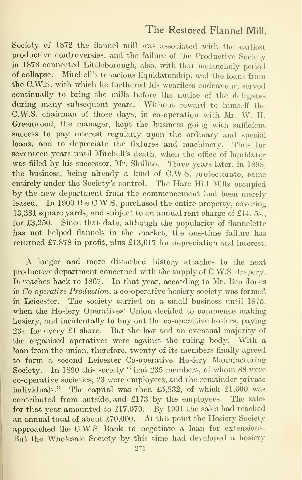Page 345 - The_story_of_the_C._W._S._The_jubilee_history_of_the_cooperative_wholesale_society,_limited._1863-1913_(IA_storyofcwsjubill00redf) (1)_Neat
P. 345
The Restored Flannel Mill.
Society of 1872 the flannel mill was associated with tlic carUest
productive controversies, and the failui-e of the Productive Society
in 1878 connected Littleborougli, also, \vith that melancholy period
of collapse. Mitchell's tenacious liquidatorship, and the loans from
the C.W.S. with which he furthered his weariless endeavour, served
continually to bring the miUs before the notice of the delegates
during many subsequent 3''ears. Without reward to himself the
C.W.S. chakman of those days, in co-operation with IVIr. W. H.
Greenwood, the manager, kept the business going with sufficient
success to pay interest regularly upon the ordinary and special
loans, and to depreciate the fixtures and machinery. Thus for
seventeen years until Mitchell's death, when the office of hquidator
was filled by his successor, Mr. Shillito. Three years later, in 1898,
the business, being already a kind of C.W.S. protectorate, came
entirely under the Society's control. The Hare Hill Mills occupied
by the new department from the commencement had been merely
leased. In 1900 the C.W.S. purchased the entire property, covering
13,381 square yards, and subject to an annual rent charge of £14. 5s.,
for £3,250. Since that date, although the popularity of flannelette
has not helped flannels in the market, the one-time failure has
returned £7,878 in profit, plus £13,617 for depreciation and interest.
A longer and more disturbed history attaches to the next
productive department concerned with the supply of C.W.S. drapery.
It reaches back to 1867. In that year, according to Mr. Ben Jones
in Co-operative Production, a co-operative hosiery society was formed
in Leicester. The society carried on a small business until 1875,
when the Hosiery Operatives' Union decided to commence making
hosiery, and incidentally to buy out the co-operative hosiers, paying
233. for every £1 share. But the law and an eventual majority of
the organised operatives were against the ruhng body. With a
loan from the imion, therefore, twenty of its members finally agreed
to form a second Leicester Co-operative Hosiery Manufacturing
Society. In 1890 this society " had 235 members, of whom 88 were
co-operative societies, 23 were employees, and the remainder private
individuals." The capital was then £5,832, of which £1,600 was
contributed from outside, and £173 by the employees. The sales
for that year amounted to £17,079. By 1901 the sales had reached
an annual total of about £70,000. At this point the Hosiery Society
approached the C.W.S. Bank to negotiate a loan for extensions.
But the Wholesale Society by this time had developed a hosiery
271

